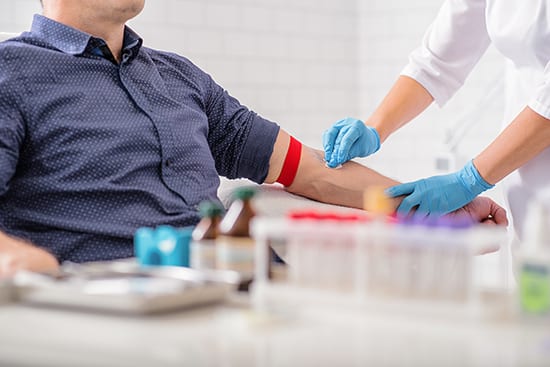
Typically, celiac disease testing starts with antibody serology tests. If positive, they are often followed up with an upper endoscopy to confirm the diagnosis. Genetic testing can also help rule out celiac disease. Read more below to learn more about getting tested for celiac disease. It is important to not start a gluten-free diet prior to testing for celiac disease.
Almost all systems and parts of the body may be affected by celiac disease. As a result, it is a bit of a clinical chameleon that wears many disguises. Knowing when to undergo celiac disease testing can be quite difficult largely because the symptoms often mimic those of other diseases, including irritable bowel syndrome (IBS), Crohn’s disease, intestinal infections, lactose intolerance and depression.
There are more than 300 symptoms of celiac disease, a serious genetic autoimmune disease. Symptoms may vary among different people.
Some of the most common signs and symptoms of celiac disease include:
Learn more about symptoms of celiac disease
A review of the evidence shows that the blood tests used in the US have a high rate of accuracy. The IgA-tTG test has the advantages of being simple, inexpensive, widely available and typically covered by insurance, in addition to being very accurate in cases of untreated celiac disease.
Blood tests are the first step in a diagnosis of celiac disease. A doctor will order one or more of a series of blood tests to measure your body’s response to gluten.
Currently, recommended tests include:
It is important to remain on a normal, gluten-containing diet prior to testing for celiac disease. Do not change to the gluten-free diet before being tested for celiac disease. If the blood tests and symptoms indicate celiac disease, a physician will likely suggest a biopsy of the lining of the small intestine to confirm the diagnosis. See below for more information on the biopsy.
Keep in mind that going gluten-free before being tested for celiac disease can prevent diagnosis. However, people who have already adopted the gluten-free diet without having been tested for celiac disease can undergo a”gluten challenge” in order to receive accurate test results.
Learn more about the gluten challenge
If your blood tests come back negative there is still a chance you could have celiac disease. If you have other risk factors and still suspect celiac disease, or if you are continuing to experience symptoms after a negative blood test, talk to your doctor about performing further tests such as an endoscopy or genetic screenings. Continued testing is encouraged to establish an accurate diagnosis, whether for celiac disease, non-celiac gluten sensitivity, or other diseases with similar symptoms.
To confirm a celiac disease diagnosis, your doctor may recommend an upper gastrointestinal endoscopy. This procedure will allow your doctor to identify any inflammation or damage in your small intestines, which is a sure sign of celiac disease. Your doctor will take a small biopsy of your intestines during the endoscopy, which will help to confirm your diagnosis.In order for the endoscopy to be accurate, the patient must be on a gluten-containing diet. An endoscopy may sound like a big procedure, but it only takes about 15 minutes and is a low-risk procedure.
Learn more about endoscopies for celiac testing
If your small intestinal biopsy results indicate that celiac disease is not present, but you and your doctor still suspect gluten is the cause of your symptoms, you may want to explore the possibility of non-celiac gluten sensitivity (‘gluten sensitivity’). Currently, there are no accepted methods of testing for gluten sensitivity.
Learn more about gluten sensitivity
Celiac disease damages the villi, which are finger-like projections in the small intestine. Villi are responsible for absorbing nutrients from food. Because of this, it is highly likely that people with celiac disease will be deficient in essential vitamins and nutrients when diagnosed. Laboratory tests should be done within three to six months following a diagnosis and annually for the rest of your life.
Learn more about follow-up testing for celiac disease
In order to develop celiac disease, you must have either the HLA-DQ2 or HLA-DQ8 genes. Without one of these genes, it is virtually impossible to develop celiac disease.
The celiac disease genes alone are not enough to develop celiac disease. Up to 40 percent of people have these genes, yet only a very small percentage of these people go on to develop it. That’s because an environmental trigger is necessary. This trigger can be a stressful event, illness, surgery, pregnancy, etc. Because having the genes does not automatically lead to celiac disease, genetic testing can only rule out celiac disease. It cannot concretely diagnose celiac disease.
Genetic testing is beneficial for relatives of people diagnosed with celiac disease. Since it is a genetic (hereditary) autoimmune disease, family members are also at risk for developing it. It’s recommended that relatives are given the blood test to determine if they have celiac disease. If the test is negative, it should be repeated every 2-3 years or sooner if symptoms occur. That’s because celiac disease can develop at any time. Those with negative test results can go on to get the gene test. If the gene test is negative, the relative can stop with regular screening.
Opt-in to stay up-to-date on the latest news.
Yes, I want to advance research No, I'd prefer not to